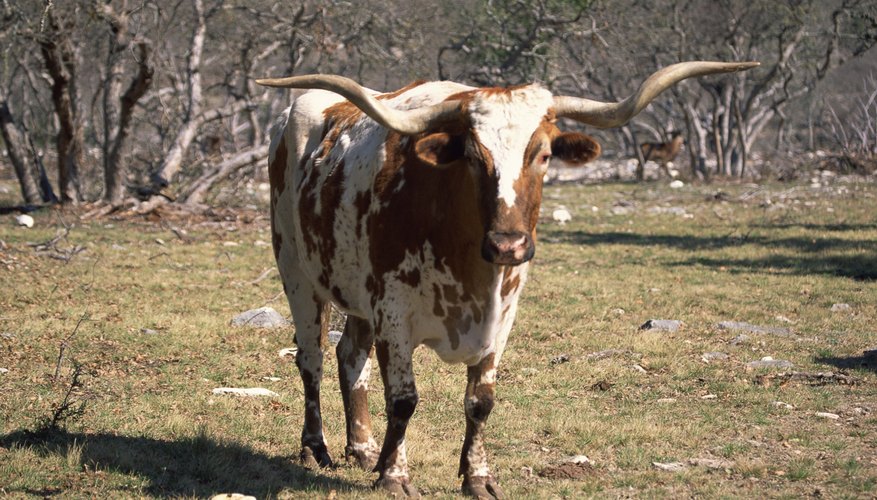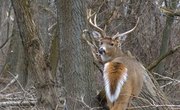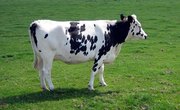
Items you will need
Fence posts and hardware
Rail boards
Metal clips
Post digger
Concrete (optional)
Power saw
Nails
Hammer
The Texas longhorn breed of cattle, sidelined as a primary beef source throughout the 20th century, may be on the verge of a comeback. After having replaced the bison as the dominant Great Plains ruminant, the longhorn was the preferred breed among cattle ranchers for the latter decades of the 1800s. However, importing and crossbreeding cattle left the longhorn behind, and the longhorn disappeared from the Plains. Still, the genetic uniformity of the imported breeds has left them less able to withstand the economic, environmental and social pressures buffeting animal agriculture. Consequently, producers are now reviewing the sturdy and durable longhorn in light of its genetic diversity. The infrastructure of cattle management -- chutes and pens -- must adapt if longhorns are indeed on the ascendancy.
Pen
Place the pen or pens at a location where shade is abundant and distractions are few. Longhorns, like all livestock, are easily stressed and distracted; you want to minimize stress as much as possible.
Select a design or plan that accommodates the cattle comfortably. Adults require 20 square feet each, while calves should be accorded 14 square feet. Gates should be at least 10 feet wide to allow clearance of the longhorns’ long horns.
Install 9-foot fence posts for the pen, corner posts first. Place intermediate posts 6 to 8 feet apart. Dig 3-foot holes with a standard fence post digger. Insert the posts and pack them with either concrete or dirt. Seal the concrete base once the posts are set in their packing.
Attach 1-inch-by-6-inch-by-9-foot rails to the post at the top and bottom, with intervening rails 6 inches apart. The bottom rail should clear the ground by 2 inches and the rails should overlap at each post. Join the rails to the posts with metal brackets.
Attach 1-inch-by-4-inch-by-6-foot horizontal rails in a similar fashion to three vertical rails of the same dimensions. Fit two rails diagonally between each end post and the center post, nailing them to the horizontal rails for additional reinforcement. Join one rail to the corner fence post using metal plate hinges and steel bolts at the top and bottom rails. Install a latch mechanism to the other side of the gate and the opposite fence post.
Chute
Get a detailed set of plans drawn by agricultural engineers. These have been perfected and tested with live cattle. Dimensions vary according to the size and number of steers. Compare your plan with existing pens and chutes.
Examine your design to ensure the optimal amount of space required for longhorns in a loading chute. While most recommendations give a maximum width of 30 inches, a few more inches may be advised to accommodate the horns.
Lay six boards, 2 inches by 6 inches by 9 feet, broad side down and side by side. Nail 1-inch-by-3-inch-by-3-foot cleats to the flooring. Estimate your longhorns’ normal stride when spacing the cleats. Extend this flooring according to the needs of your herd. Sink three fence posts on each side of the flooring – about 3 feet deep – and attach by carving 1-inch grooves at the bottom of each post with the power saw.
Attach rails of equal dimensions to the floorboards to the fence posts, as you did with the holding pen.
Affix 2-inch-by-6-inch-by-4-foot rails at the top of the chute entrance and exit, running parallel to the cleats. Nail them to the corner posts.
Tips
References
- Ohio State University Extension; Cattle Handling and Working Facilities; Stephen Boyles, Jeff Fisher and Gary Fike
- Oklahoma State University Department of Animal Science; Texas Longhorn -- Survivor of the Past – Bright Promise for the Future; Stewart H. Fowler
- Louisiana State University Ag Center Research and Extension; Two-Pen Corral and Loading Chute
Resources
Writer Bio
John Gregory has worked in the publishing and financial industries for over 20 years. He began writing for newsletters and marketing campaigns in 2003 and has since collaborated on pieces for Mortgage News and Mortgage Originator. He holds a bachelor's degree in geography from the William Paterson University of New Jersey.



